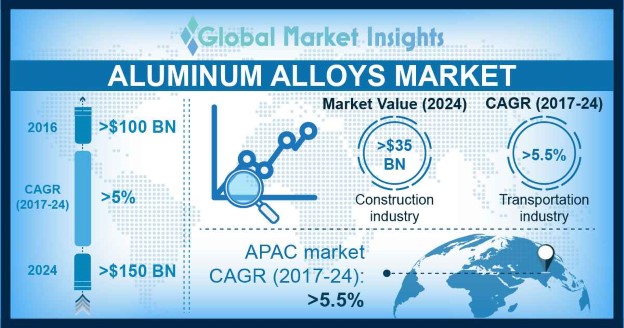Home > Chemicals & Materials > Advanced Materials > Aluminum Alloys Market
Aluminum Alloys Market Size
- Report ID: GMI1527
- Published Date: Apr 2017
- Report Format: PDF
Aluminum Alloys Market Size
Aluminum Alloys Market size was registered at over $100 billion by 2016 gaining the industry by CAGR over 5% from 2017 to 2024. Rising global tourism and corresponding demand for air, water, as well as land transportation and increasing demand for superior means of commuting in order to meet the needs for the growing industrialization will further augment the industry growth.
Worldwide automotive sales crossed 90 million units in 2016 from less than 80 million units in 2011, growing considerably after the economic slowdown of the previous decade. Majority of the passenger car sales were concentrated in the Asia Pacific region owing to the rapidly increasing GDP and purchase power of the population of China, India, and Japan. Increasing demand for light weight alloys for enhancing the vehicle performance and efficiency will have a positive influence on the aluminum alloys market in coming years.
Asia Pacific GDP growth was recorded at more than 5% in 2014, of which manufacturing contributed for a significant chunk. Overall industrial developments in China, India, South Korea, Japan, and Indonesia will play a major role in the global market in coming years. Availability of cost-efficient workforce accompanied with lenient industrial norms have invited several manufacturing conglomerates to shift their manufacturing bases in this region. Wide range of industrial application of the product including die casting, manufacturing machineries and equipment will have a positive impact on the aluminum alloys market share.
| Report Attribute | Details |
|---|---|
| Base Year: | 2016 |
| Aluminum Alloys Market Size in 2016: | 100 Billion (USD) |
| Forecast Period: | 2017 to 2024 |
| Forecast Period 2017 to 2024 CAGR: | 5% |
| 2024 Value Projection: | 150 Billion (USD) |
| Historical Data for: | 2013 to 2016 |
| No. of Pages: | 127 |
| Tables, Charts & Figures: | 157 |
| Segments covered: | Product, End-user and Region |
| Growth Drivers: |
|
| Pitfalls & Challenges: |
|
Poorly regulated bauxite mining in the straits of Malaysia and Indonesia has created several concerns regarding the ecological impact. Rise of respiratory and skin diseases due to exposure to mining dusts may pose threats to the aluminum alloys market as aluminum is procured from these ores. In the European Union bauxite mining is governed by a European Innovation Partnership (EIP) body named Bauxite Residue and Aluminium Valorisation Operations (BRAVO) which focuses on improving the aluminum value chain and secondary raw material recovery.

